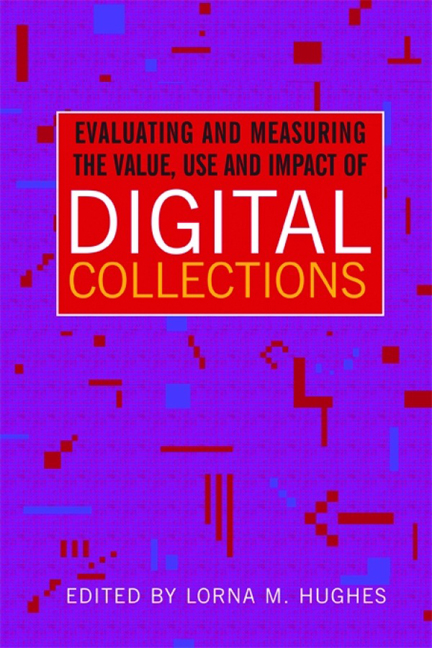Book contents
- Frontmatter
- Contents
- Figures and tables
- Foreword
- Acknowledgements
- The contributors
- 1 Introduction: the value, use and impact of digital collections
- Part 1 Digital transformations in libraries, museums and archives
- Part 2 Understanding and measuring the use, impact and value of digital collections
- 5 A strategic approach to the understanding and evaluation of impact
- 6 User needs in digitization
- 7 Measuring impact and use: scholarly information-seeking behaviour
- 8 The value and impact of digitized resources for learning, teaching, research and enjoyment
- Part 3 Enhancing the future impact and value of digital collections
- References and further reading
- Index
- Miscellaneous Endmatter
- Miscellaneous Endmatter
7 - Measuring impact and use: scholarly information-seeking behaviour
from Part 2 - Understanding and measuring the use, impact and value of digital collections
Published online by Cambridge University Press: 08 June 2018
- Frontmatter
- Contents
- Figures and tables
- Foreword
- Acknowledgements
- The contributors
- 1 Introduction: the value, use and impact of digital collections
- Part 1 Digital transformations in libraries, museums and archives
- Part 2 Understanding and measuring the use, impact and value of digital collections
- 5 A strategic approach to the understanding and evaluation of impact
- 6 User needs in digitization
- 7 Measuring impact and use: scholarly information-seeking behaviour
- 8 The value and impact of digitized resources for learning, teaching, research and enjoyment
- Part 3 Enhancing the future impact and value of digital collections
- References and further reading
- Index
- Miscellaneous Endmatter
- Miscellaneous Endmatter
Summary
Introduction
Emergent information technologies offer museum professionals new ways of bringing information about their collections directly to their audiences. There is a strong ethos within museums to widen public access to collections via the ever-growing digital provision of collections data. Over the past decade, the number of online museum collections, and the number of online visitors using those collections, has increased significantly. These changes have posed challenges for museum professionals and academics alike, seeking to understand how digital museum resources feature in the information seeking practices of their online visitors.
There are now vast amounts of digital museum resources available to support scholarship. These resources are changing the ways researchers work, offering convenient quick access to a wide selection of materials, particularly with regard to cultural heritage content. However, finding information in museums, as well as libraries and archives (memory institutions), is not an easy task. Collections database information systems can be overwhelming and daunting to many users. Designing intuitive systems that meet researchers’ needs requires a thorough understanding of the information-seeking behaviour of collection database users. A proper understanding of how museum visitors use digital museum resources is critical for the success of museums in the information age. As museums cope with the challenges of ‘being digital’ (Hamma, 2004), meeting the information needs of online visitors has become an important part of the museum's role (Marty, 2004) and it is now critical for researchers and museum professionals to explore the use of museum digital resources, in-house and online (Booth, 1999; Sarraf, 1999).
The British Museum has a commitment to expanding virtual and physical access to its collections, utilizing different mediums to open up the museum collections to a wider, more diverse audience. In October 2007, it launched an online version of its collections database, British Museum Collection Database Online (COL2). By the end of 2009, nearly two million records from the museum collections had been made available to the public worldwide. Despite recent technical advances in collections access and interpretation, very little is known about whether and how this material is used, or if it makes possible new kinds of engagement with museum objects.
- Type
- Chapter
- Information
- Publisher: FacetPrint publication year: 2011



